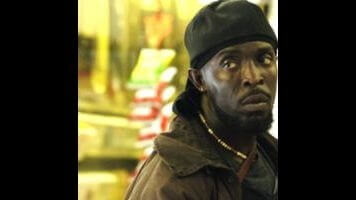The Wire: "The Dickensian Aspect"

Two big cliffhangers from last week: How in the world did Omar survive that three-story fall from the Chris/Snoop/Michael ambush? And what was that strange interference on Marlo’s cell phone tap?
First, Omar: With Marlo’s crew combing the area for what has to be a horribly injured man—I particularly enjoyed Snoop’s concerned inquiry at the local hospitals, which would raise red flags even if Omar had landed at one of them—it turns out our favorite anti-hero is hidden right under their noses. His leg shattered by the fall, Omar patches himself up in the janitor’s closet of the very building from which he leapt, hiding in plain sight. In last week’s recap, I felt the “Spider-Man shit” he pulled to escape certain peril was very much in keeping with the Omar legend. But there’s more to it than that: One of the odd contradictions about Omar is that he may seem indestructible, but he’s always been vulnerable to injury and betrayal. He’s not just a specter haunting the streets of Baltimore, but a man who has lost many friends and lovers, and who has to improvise in order to survive.
And yet, I’m going to go out on a limb and predict that Omar lives through the end of the season. I know there’s a good argument to be made that this iconic figure will go out in a blaze of glory like some Old West outlaw. But to me, Omar the urban legend remains transcendent; he needs to exist as a boogeyman on the streets of Baltimore, if only as a reminder to those in “The Game” that they have a short life expectancy. And he’s especially dangerous to hubristic kingpins like Marlo, who are arrogant enough to believe that they’re bulletproof. Proposition Joe’s life was eventually ended by treachery, but he lasted longer than most because he was wise enough to know that a little diplomacy and humility could keep him operating smoothly into the future. Power grabs like Marlo’s are dramatic but short-lived; and Omar has the scalps to show for it.
As for Marlo’s cell phone tap, it turns out the interference is coming from photo files that are transferred in lieu of the spoken word. It seems like any form of telecommunication would leave Marlo and his crew exposed, though knowing his reputation for fastidiousness, he probably has codes within codes devised in case the authorities intercept his transmissions. Photographs of Marlo posing in front of a drug shipment with a big smile on his face seem highly unlikely. (As does text-messages, per Lester: “Text? Need I remind you, detective, that these boys are the product of Baltimore City Schools?”)
The real significance of these photo transmissions, however, is what it means to McNulty, Lester, and their phony homeless murders case. Veterans that they are, McNulty and Lester probably should have anticipated that increased local and national interest in their fake serial killer doesn’t mean increased funding for the department. The mayor offers some impassioned soundbites in his big speech about the homeless and he certainly wants to capture the guilty party, but he’s not willing to make any politically compromising efforts to do it. So we’re left with “more with less” again: The police are told to solve these murders, but they don’t have the tools or manpower to do it. (Which is fine, really, since the deaths aren’t really murders.)
This week, McNulty and Lester’s until-now farcical attempts to create a serial killer take a darker turn, as McNulty essentially kidnaps a homeless man and drives him out of town just to make the picture-phone tap stick, and Bunk’s old-fashioned investigation of the 22 bodies gets put on the back burner because of the fake homeless murders. It’s great to watch a veteran like Bunk turn over all the old stones again, presuming not unreasonably that his quiet persistence stands as good a chance at nabbing Marlo as the wire bought by McNulty’s scheme. As his pal Jimmy scrambles to get surveillance on the Sun and tuck a homeless man out of town, Bunk works the case in much the same way as Jimmy professed to work the case before the mayor pulled the plug on it. There are serious stumbling blocks in play—like the understaffed lab that misplaced trace evidence from all 22 cases in a temp filing error (“Except for that, she’s been a pretty good employee”)—but he seems intent on following the thread, and I wouldn’t be surprised to see him wrap up the case before McNulty and Lester have the chance. With Michael’s mom flapping her gums, Bunk now has a good person to lean on, and a possible ticket into Marlo’s inner circle.
 Keep scrolling for more great stories.
Keep scrolling for more great stories.
